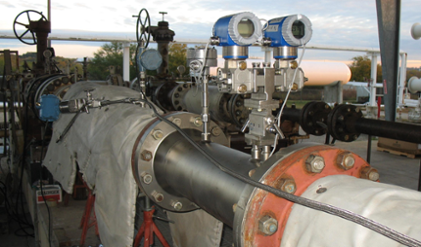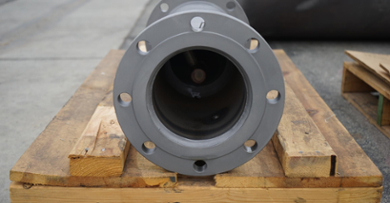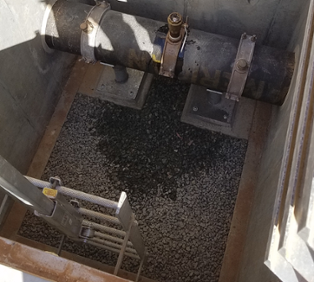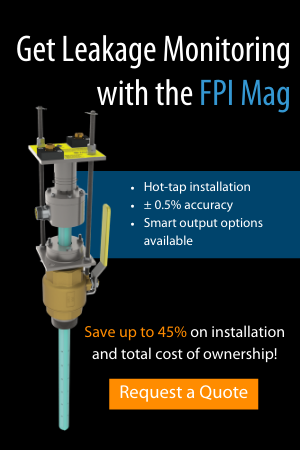Steam Flow Applications in a Combined-Cycle Power Plant
What is a Combined-Cycle Power Plant?
A combined-cycle power plant is any plant that relies on multiple cycles of power generation sources to generate electricity, such as a natural gas, steam, hydro power, coal, and more. These plants utilize a combined-cycle method of multiple fuel sources powering turbines that create mechanical energy. This allows the plant to cut down on initial fuel costs, achieve more efficiency, and reduce their overall carbon footprint. By generating power from a dual-phase system, a plant can generate heat and utilize the otherwise wasted exhaust, in a heat recovery steam generator (HRSG).
The Importance of Steam in a Combined Cycle Power Plant
Steam is a central factor in a combined-cycle power plant, as its production and usage contribute significantly to a plant’s efficiency score. In previous decades, steam leaks and flow measurement weren’t considered essential as they are today; now, plant managers and instrumentation engineers are prioritizing steam flow measurement because steam loss equates to revenue loss. If a plant is leaking sellable steam, that’s revenue going to waste — plants cannot bill customers or run an efficient power plant with significant leakage.
There are numerous flow measurement points in a combined-cycle plant, on both the manufacturing and the distribution sides of the operation.
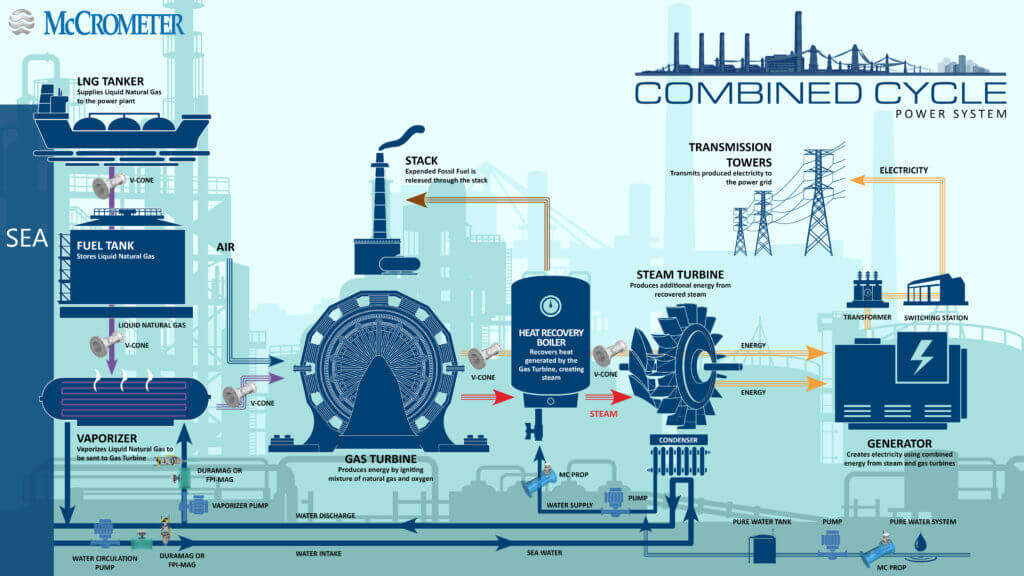
A diagram showing the various components of a combined-cycle power plant.
- Boiler/Heat Exchanger: Steam exhaust produced from the first phase of the combustion generator is captured in an HRSG, a heat recovery steam generator. Additional steam is added to the steam exhaust, courtesy of a boiler, and routed to the steam turbine. Capturing the steam exhaust measurement allows engineers and plant managers to understand their operational efficiency.
- Steam turbine: After steam exits the HRSG, it is routed to a steam turbine to generate more power. Since the steam turbine is powered using the leftover heat from the initial gas turbine, this cycle of power generation is resourceful. Measuring the amount of steam produced and utilized here equips plant engineers with valuable data to determine efficiency in energy production.
- Condenser: After powering the steam turbine, the steam is then routed to a condenser for liquification, to repeat the process. Utilizing condenser water rather than feedwater streamlines the power generation process, as impurities in the water source have already been removed and the condenser water can immediately be utilized in the turbines. Measuring the steam outlet flow from the turbine into the condenser provides plant operators another efficiency data point.
- Distributed steam: The amount of distributed steam used affects a plant’s billing and revenue goals. Measuring this flow accurately is critical, especially when customer demand and seasonality affect the rate of flow and quantity.
The Benefits of Accurate and Reliable Flow Measurement
Implementing an accurate and dependable flow measurement strategy is critical to a plant’s efficiency and bottom line. For cogeneration plants, facilities that produce steam heating and electricity, knowing the flow of steam is critical for billing. Many large cities and industrial parks rely on steam heating and have networks of piping beneath buildings and streets with the potential for unnoticed leaks. Multiple flow meters installed at various distribution points can act as diagnostic tools, providing critical flow data pinpointing leakage and steam loss.
Metering steam in a combined-cycle power plant is driven by the need to understand operational efficiency and billing accuracy, both of which require robust, precise measurement instruments. There are a handful of metering technologies that meet these requirements:
- Orifice plates: A very economical flow meter, the orifice plate is a well-recognized and usually universally understood differential pressure device. Unfortunately, these meters usually require significant straight-run, and don’t often boast long lifespans, as high pressure or corrosive flow media can dull the edges of the plate, effectively changing the geometries of the plate and affecting meter accuracy and repeatability.
- V-Cone® meters: Ideal for retrofit installations, the V-Cone requires minimal-to-no straight-run due to its self-conditioning technology. Withstanding high temperatures and pressures, as well as mixed-media steam such as superheated steam and wet gas, the V-Cone can be customized in a variety of basic and exotic materials. The V-Cone boasts a lifespan of 25+ years, and is extremely accurate at ±0.5% accuracy.
- Venturi meters: A very precise meter, the Venturi can measure a variety of flows including steam. They’re very customizable in material construction, and can be installed vertically, horizontally, or inclined. Head loss isn’t a big issue for this meter, but price may be a concern, especially at large line sizes.
- Vortex meters: The vortex meter can handle a wide turndown and is generally unaffected by changes in temperature or pressure in the line. However, if the flow is low enough and doesn’t create enough vortices, the meter can’t be relied on to accurately measure flow. The vortex is often an economical option, especially for small line sizes, but requires upwards of 10 diameters upstream straight run — often more.
Why a McCrometer V-Cone for Combined-Cycle Power Plants?
The V-Cone is a highly robust product that can tolerate the high pressure, high-temperature steam produced in combined-cycle power plants. Additionally, in cogeneration plants that are distributing steam as well as energy, accommodating seasonality and customer demand is critical. The V-Cone has low permanent pressure drop and performs well despite changing flow rates, as the meter boasts a 10:1 turndown—even a 20:1 turndown utilizing stacked transmitters. Other meters, such as the orifice plate, have trouble with low steam flow, suffering corrosion which affects meter integrity.
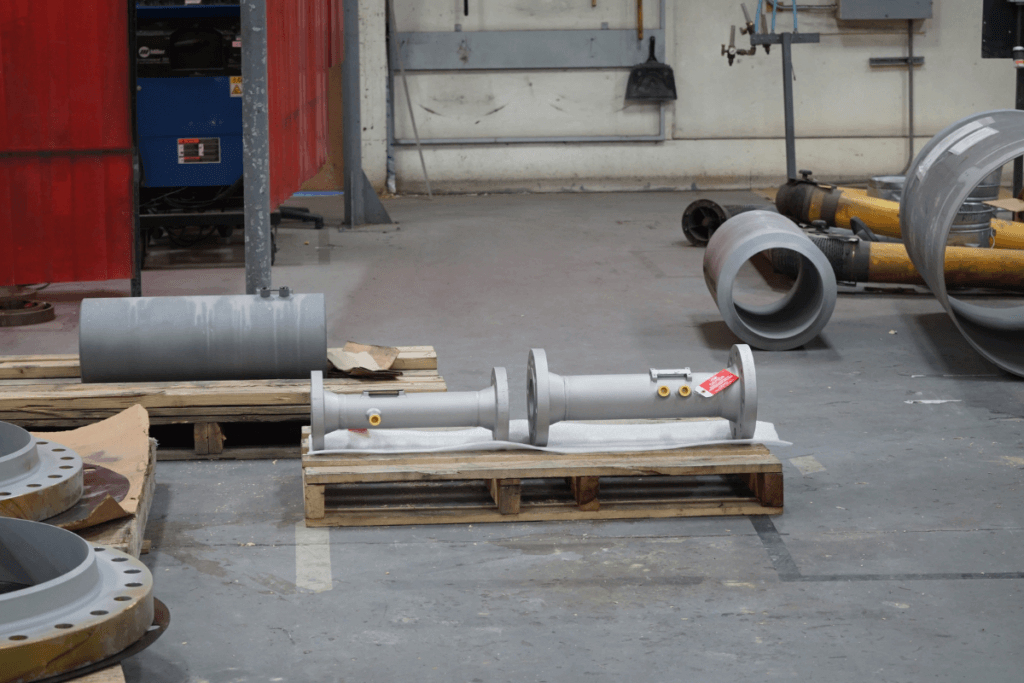
V-Cones in various stages of manufacturing at the McCrometer factory.
Retrofit-Friendly: Many metering projects in North America are retrofit installations, which limits the available space to accommodate a meter requiring significant straight-run requirements. The larger the nominal pipe size, the greater the need for re-piping to satisfy meters such as the vortex. The V-Cone, on the other hand, requires minimal-to-no straight-run, making it an ideal meter for power plant retrofits. A variety of end connections, taps, and available transmitters make the meter easy to incorporate into existing pipelines and systems.
Manufactured in the USA: The V-Cone is manufactured in-house at McCrometer’s factory located in Hemet, California, meeting and exceeding a number of standards and regulations, including ISO 9001:2015, PED, NSF, and more. Our manufacturing standards contribute to meter quality and ensure long-term flow measurement performance for our customers’ power plants.
Get Started!
For more information on the V-Cone for steam flow measurement, or to receive a quote for your open flow project, reach out to the McCrometer factory or contact your local McCrometer authorized representative.
Related Posts
Featured Posts
3 Reasons Why Budget-Focused Farmers Invest in Integrated Telemetry
Allocating budget to flow technology may seem unjustifiable when funds are tight; flow meters and their electronics may already be installed, giving no reason to replace or add additional units when the current solution is in fine working condition. However, flow...
Small Package, Big Impact: The Importance of Desiccant Cartridge Maintenance
You’ve likely seen a desiccant cartridge, in the form of the small silica gel packet accompanying food products, or the activated carbon packet at the top of pharmaceutical bottles. It’s also commonly used in electronics and near sensors, especially for...
Meeting BABA Compliance and Expanding Opportunities
Content Recorded and Published at WEFTEC in October 2024 In this episode of The Water Online Show: On Location, (now former) McCrometer President Pete Oveson dives into the company's story and recent developments shaping its future. He begins with an overview of...
Request More Information

